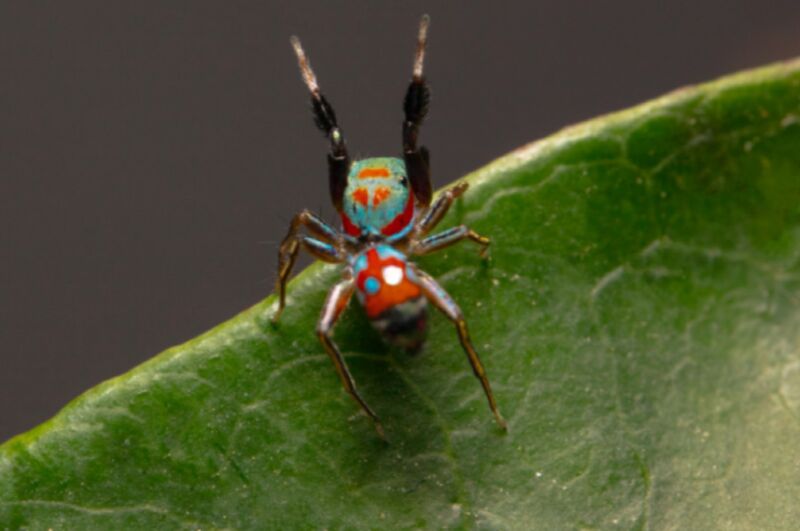
We typically think of camouflage in nature in terms of bodily colouration, enabling the species to blend in with the background and evade predators. But previous studies have documented locomotor mimicry in some species, like swallowtail butterflies and clearwing moths, as well as the jumping spider Myrmarachne formicaria, which mimics the limb use and general movement of ants. The latter is an example of perfect mimicry, generally assumed to be most effective in terms of evading predators.
But Hua Zeng, an ecologist at Peking University in China, and colleagues were intrigued by the colourful jumping spider Siler collingwoodi, which exhibits imperfect mimicry, and decided to run some lab experiments to determine how this might confer protective benefits They also set out to explore the effectiveness of the spider's colouration as a camouflage strategy, describing their results in a new paper published in the journal iScience.
“Unlike typical ant-mimicking spiders that mimic the brown or black body colour of ants, S. collingwoodi has brilliant body colouration,” said Zeng. “From a human’s perspective, it seems to blend well with plants in its environment, but we wanted to test whether their body colouration served as camouflage to protect against predators.”
The team first noticed the locomotor mimicry while collecting samples of S. collingwoodi from four regions in southern Hainan. The spiders adapted what the authors term a "stop-and-go" walking pattern similar to ants, which involves extending its first pair of legs up and forward, essentially mimicking an ant's antenna. For their experiments, they also collected five different species of ants that shared the environment with the spiders, as well as a non-ant-mimicking jumping spider, Phintelloides versicolour. Finally, they collected samples of two potential predators: one a species of spider that hunts and consumes other spiders, and the other a praying mantis, a more generalist predator with a monochromatic visual system.
First, Zeng et al. analyzed the trajectory and gait of S. collingwoodi and the five species of ants. Here's how an ant walks:
And here's how the Siler collingwoodi jumping spider mimics that walk:
And here's how the Siler collingwoodi jumping spider mimics that walk:
The authors noted marked similarities, particularly with the smaller ant species that were roughly the same size as the spider. In addition to raising their front legs, S. collingwoodi bobbed their abdomens. “S. collingwoodi is not necessarily a perfect mimic, because its gait and trajectory show high similarity with multiple ant species,” said Zeng. “Being a general mimic rather than perfectly mimicking one ant species could benefit the spiders by allowing them to expand their range if the ant models occupy different habitats.”
Next, they tested the effectiveness of this ant-mimicking defense strategy with a series of anti-predation experiments, exposing both S. collingwoodi and the non-mimicking Phi. versicolour to the predatory spiders and praying mantises. Given the choice, the predator spiders were more likely to attack the non-mimicking jumping spiders, while praying mantises attacked both equally. The authors suggest that this is due to size. For the smaller predatory spider, accidentally ingesting a spun ant could cause injury, which would not be a concern for the much larger praying mantis.
As for the bright body colouration of S. collingwoodi, Zeng et al. conducted a background matching colour analysis of those spiders with the five ant species and the non-mimicking spiders, as well as two common plants favored by S. collingwoodi: the red-flowering West Indian jasmine, and the Fukien tea tree. S. collingwoodiproved to be better hidden from predatory spiders and praying mantises when lurking on jasmine plants rather than tea trees. The authors concluded that this species of jumping spider relies on a combination of imperfect ant mimicry and colouration camouflage to ward off predators.
DOI: iScience, 2023. 10.1016/j.isci.2023.106747 (About DOIs).



3175x175(CURRENT).thumb.jpg.b05acc060982b36f5891ba728e6d953c.jpg)
Recommended Comments
There are no comments to display.
Join the conversation
You can post now and register later. If you have an account, sign in now to post with your account.
Note: Your post will require moderator approval before it will be visible.